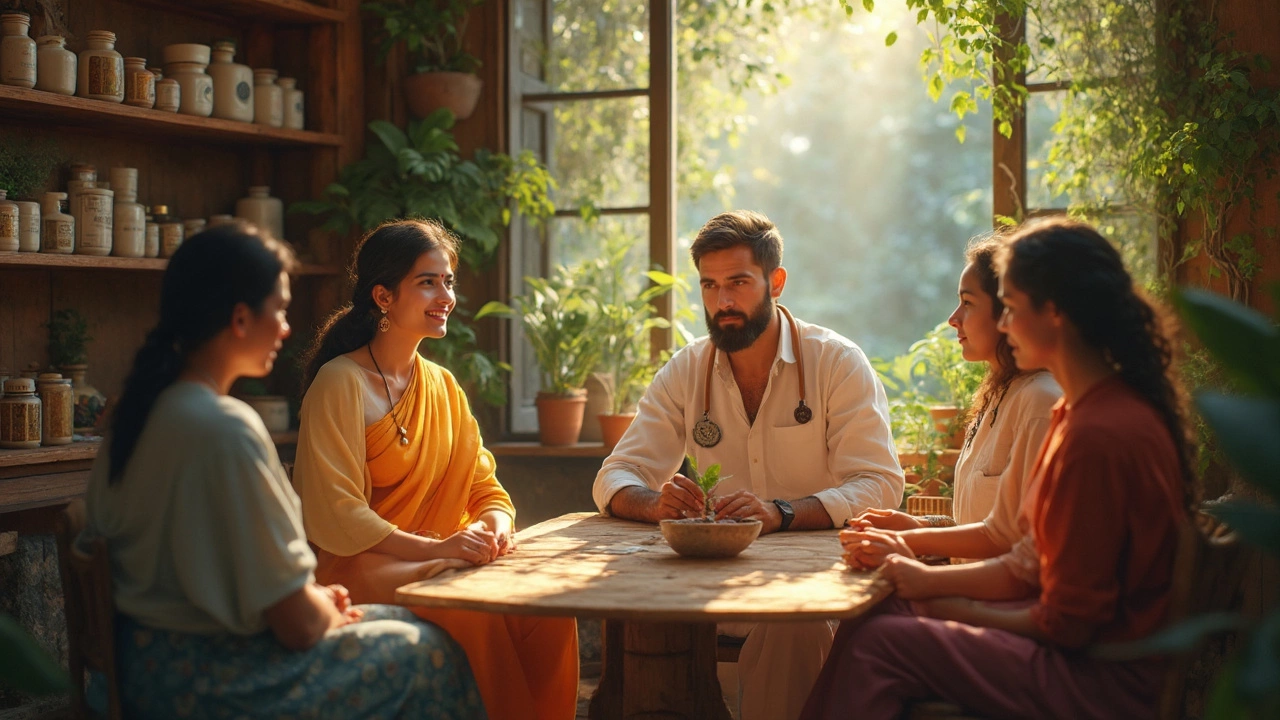When people hear the word "Ayurveda," they usually picture herbs, mysterious powders, or intense oil massages. But Ayurveda is a full-on life system—it’s like a blueprint for staying healthy, not just a quick fix for headaches or colds.
Here’s the catch: Ayurveda doesn’t really promise to ‘cure’ diseases the way we expect from antibiotics or surgery. Instead, it aims to balance your body, so it can avoid or manage stuff like diabetes, arthritis, skin troubles, and even gut issues. A lot of folks dealing with problems doctors call ‘chronic’—meaning they don’t disappear after a pill or a round of treatment—find some hope in Ayurveda.
But before you toss out your pain meds and go all-in on herbal teas, it’s smart to know what Ayurveda is actually good for. I’ve seen people use simple Ayurvedic routines—think turmeric milk for coughs or ashwagandha for stress—and feel better. Still, don't expect miracles for every problem. Understanding what this 3,000-year-old system does (and doesn’t do) could save you a ton of time and confusion.
- Ayurveda’s Approach: Not Just Pills and Potions
- Chronic Conditions: What Ayurveda Handles Best
- Where Modern Medicine Wins (and Ayurveda Doesn’t)
- Tips for Safe and Smart Ayurvedic Use
- Mixing Ayurveda With Everyday Health
Ayurveda’s Approach: Not Just Pills and Potions
Most people think ayurvedic medicine is just about herbs, oils, and maybe a weird diet. But honestly, it’s bigger than that. Ayurveda works on the idea that your body, mind, and even your habits all matter for your health. You won’t just be handed some powder and sent home. An Ayurvedic doc usually digs deep—asking about your sleep, stress, food cravings, and how often you get heartburn. No surprise, right? Today, nearly 80% of people in India use some form of Ayurveda, not just for pain but for stuff like sleep issues or gut health.
Here’s how Ayurveda tackles disease:
- Diagnosis is personal. Two people could have joint pain but get totally different advice—one might be told to cool down their diet, another might be asked to do more yoga or breathing exercises.
- Food is medicine. Ayurveda looks at what you eat and how it affects your “doshas” (body energies), which have weird names like Vata, Pitta, and Kapha. If your digestion’s off, don’t be shocked if you’re told to swap spicy snacks for warm rice porridge.
- Daily routines are a huge deal. There’s even a word for it—“Dinacharya.” Regular sleep, specific wake-up times, oil massages, and even tongue scraping all count.
- Mind matters. Meditation, stress management, even positive thinking are pushed just as much as herbs.
- Treatments go beyond swallowing stuff. You’ve got things like steam baths, nasal therapies, and even specialty massages that are supposed to clear out toxins.
Check out this quick table for the main tools Ayurveda usually uses:
| Ayurvedic Tool | What It Does | Common Example |
|---|---|---|
| Herbs & Powders | Support systems, fight symptoms | Turmeric for inflammation, Ashwagandha for stress |
| Diet Changes | Restore digestion, balance energy | Warming foods for joint pain, easy-to-digest meals |
| Daily Habits | Improve rhythm, boost immunity | Oil pulling, early waking, tongue scraping |
| Mental Health | Reduce stress, improve mood | Yoga, meditation, breathing exercises |
| Detox Treatments (Panchakarma) | Remove toxins, restart body systems | Herbal enemas, steam therapy, massage |
So yeah, while herbs and potions are what everyone talks about, real Ayurvedic treatment is more like a full system reset. If you’re looking to just pop a pill and go, Ayurveda might not be your thing. But if you want a big-picture look at your health, you’ll see there’s a lot more going on behind the scenes.
Chronic Conditions: What Ayurveda Handles Best
When it comes to nagging health problems that just won’t go away, Ayurveda has gained quite a reputation. We're talking about stuff like joint pain, skin flare-ups, gut issues, and stress that hangs around for months or years. In India and now worldwide, plenty of people turn to Ayurveda when regular meds either don't fully work or cause annoying side effects.
Let’s look at specific areas where this ancient system tends to shine:
- Ayurveda is famous for arthritis and joint disorders. People use herbal combos (like guggul and ashwagandha), plus oil massages and diet tweaks. Studies from India’s Central Council for Research in Ayurvedic Sciences have shown some solid results, especially for osteoarthritis and rheumatoid arthritis.
- Gut problems like irritable bowel syndrome (IBS), recurring acidity, or constipation are bread-and-butter cases in Ayurveda. Treatments include triphala (a blend of three fruits), herbal teas, and routines like abhyanga (oil self-massage) to get digestion working smoothly.
- Skin hassles such as psoriasis, eczema, and acne respond well to both internal herbs and topical remedies. Neem, turmeric, and manjistha are go-tos. If you know someone with recurring skin rashes who’s fed up with steroid creams, they’ve probably tried one of these Ayurvedic approaches.
- Chronic stress and anxiety are now global issues, not just city problems. People swear by Ayurvedic adaptogens like ashwagandha and brahmi, plus breathing and meditation (pranayama) for keeping their cool when life throws curveballs.
- Problems like diabetes and high blood pressure don’t get “cured” by Ayurveda, but therapies and lifestyle changes can help make blood sugar and BP more manageable. Herbs like fenugreek, bitter melon, and arjuna bark are often used alongside routine checkups.
Here’s something practical: real relief usually comes from personalized plans. Two people with arthritis might get totally different herbs, massages, and food advice, depending on their body type (what Ayurveda calls "dosha"). So, the one-size-fits-all thing? That doesn't really work here.
If you’re thinking about trying any of these, find a qualified practitioner, not just someone selling powders online. The right advice makes all the difference, especially when you’ve got a chronic issue that needs steady care, not just temporary fixes.

Where Modern Medicine Wins (and Ayurveda Doesn’t)
Let’s get real—there are times when you want a hospital, not a home remedy. If you break your arm or get hit with a nasty infection like pneumonia, modern medicine steps in with things Ayurveda can’t match. No herbal paste is going to set bones or zap bacteria like antibiotics. In these cases, delays can actually be dangerous.
Emergency care, life-saving surgeries, cancer treatments, and vaccines all come from years of clinical research, testing, and full-on science. That’s not something Ayurveda is built for. If you’re facing a heart attack, stroke, severe infections, or any life-threatening condition, the ER is your best friend. Diabetes complications, kidney failure, and organ transplants are other examples—Ayurveda just doesn’t have proven answers here.
Let’s talk numbers. For something like sepsis—when the body goes haywire due to infection—modern intensive care brings death rates down to around 10–20%, depending on the country. Without these advances, those survival odds tank fast. Have a look at how differently the two approaches stack up in certain cases:
| Condition | Modern Medicine Effective? | Ayurveda Effective? |
|---|---|---|
| Broken Bones | Yes, with surgery/casting | No |
| Heart Attacks | Yes, with emergency care | No |
| Type 1 Diabetes | Yes, with insulin | No |
| Infections (e.g., pneumonia) | Yes, with antibiotics | No |
| Organ Transplants | Yes | No |
Ayurveda does shine for some ongoing issues, usually where the risk is low and treatments focus on lifestyle. But when it’s urgent or life-threatening, don’t gamble—see a doctor first.
- If symptoms are severe or come on suddenly, call for medical help. Don’t wait and try home remedies.
- Use Ayurveda as an add-on—not a replacement—after checking with your doctor, especially for serious diagnoses.
The point here isn't to trash Ayurveda, but to know when it’s outmatched. There’s nothing wrong with wanting gentle, natural support. Just remember, the right tool for the job can make all the difference.
So, if you’re dealing with high-stakes health issues, stick to what’s proven. Ayurveda can be explored safely when things are calm, but when it comes to emergencies, modern medicine wins every time. That peace of mind? Worth it.
Tips for Safe and Smart Ayurvedic Use
Ayurveda gets a lot of hype these days, but don’t just jump in without a bit of homework. Some herbal blends can actually mix badly with your regular medication—it’s not always "natural, so it’s safe." So, if you’re dealing with serious stuff like diabetes, high blood pressure, or heart issues, talk to your doctor before starting any Ayurveda treatments.
Want to try Ayurvedic products? Read labels and make sure you’re getting real stuff. There have been cases worldwide where certain products contained heavy metals or harmful additives. Not every supplement on the shelf is checked by strict authorities.
- Go for trusted brands that show third-party testing or certifications.
- Ask the practitioner where their ingredients come from and how they’re processed.
- If you notice anything weird—rash, stomach issues, or just don’t feel right—stop using the product and tell your healthcare provider.
Combining Ayurveda with your usual medicine isn’t always a problem, but timing and dosages matter. Example: taking some herbs with your thyroid medicine could actually mess with your test results or symptoms. Track how you feel, good or bad, and keep your doctor in the loop.
If you really want to see if Ayurveda works for you in the long run, don’t just rely on treatments for a week and expect magic. Stick to daily routines, meals, and habits that match your body type (Ayurveda calls it "dosha").
| Ayurvedic Use | Smart Tip |
|---|---|
| Herbal Supplements | Check for certifications and avoid anything unlabelled |
| Massage Oils | Do a patch test to avoid allergic reactions |
| Diet Changes | Start slow and see how your body responds |
| Lifestyle Routines | Stick with habits at least 2-3 weeks before judging results |
And honestly, no matter what you see on social media, don’t mess around with stuff like "detox" plans or hard-core cleanses without professional help. A true Ayurvedic practitioner won’t give you a one-size-fits-all pill—they’ll look at your whole daily routine, not just your symptoms. It’s all about the big picture.

Mixing Ayurveda With Everyday Health
Ayurveda isn’t just for people with serious health issues. You can use its basics every day, even if you consider yourself pretty healthy. Think of it as a toolkit—tiny habits add up, and you don’t have to switch your entire routine overnight.
Most people start with diet. Ayurveda suggests eating in tune with your body type and the season. For instance, if you get bloated after eating heavy meals, try swapping out cold foods for warm soups and teas for a while. Or if you feel sluggish in summer, lighter, hydrating foods can help. These aren’t strict rules, but guidelines you adjust until your body feels “right.”
Daily routines, called Dinacharya, are another popular entry. These simple habits include:
- Drinking a glass of warm water in the morning to kickstart digestion
- Taking short walks after meals instead of flopping on the couch
- Tongue scraping to keep your mouth fresh and your tummy happier
- Swapping late-night screen time for an earlier bedtime and morning sunlight exposure
Herbal support is everywhere in Ayurveda, but skip mystery powders unless you know what you’re taking. Popular herbs like ashwagandha for stress and triphala for digestion are generally well-tolerated, but always check for any personal allergies first. A lot of people see results from these small tweaks instead of going full-on herbal detox.
| Ayurvedic Habit | Reported Benefit | Regularity (Days per Week) |
|---|---|---|
| Warm water every morning | Better digestion, less constipation | 5-7 |
| Tongue scraping | Fresher breath, fewer stomach upsets | 5-7 |
| Short post-meal walk | Less bloating, steady energy | 4-7 |
| Taking ashwagandha | Lower stress, sleep improvement | 3-7 |
Balancing modern routines with Ayurveda is about slow, steady changes. You don’t need an expensive consultation to start, but if you’re dealing with something specific—like blood pressure or bad allergies—check with a real doctor before doubling up on remedies.
One last thing: remember that Ayurveda is about listening to your own body. There's a reason why people keep coming back to this ancient system after trying out everything else. When you make small changes and pay attention to how you feel, that's where the real benefit kicks in.





